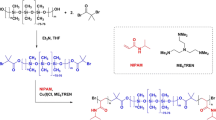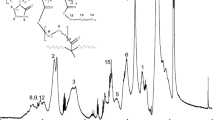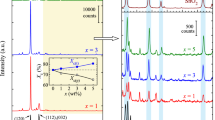Abstract
1H NMR spectroscopy was used for the first time to investigate temperature behaviour of aqueous solutions of nanoparticles (NPs) prepared from linear and Y-shape terpolymers containing blocks of poly(ethylene oxide) (PEO), poly(2-ethyl-2-oxazoline) (PEtOx) and one linear or two star poly(ε-caprolactone) (PCL) blocks with different length. Structural changes were characterized separately for all blocks in a temperature range 295–360 K, and a broad transition was observed at temperatures above ~320 K. The temperature behaviour of NPs solutions depends on polymer concentration and especially on terpolymer architecture. At the same time, NMR measurements revealed important role of PCL blocks in this behaviour. The spin-spin relaxation times T 2 of water (HDO) give information on the behaviour of water and on polymer-water interactions within the aforementioned temperature range. In NPs solutions of the linear copolymer, two types of water were detected at higher temperatures: “free” and “bound” water molecules with long and very short T 2 values, respectively. For NPs solution of non-linear terpolymer, two types of water were observed only for the highest used (1.5 wt%) polymer concentration.









Similar content being viewed by others
References
Mai Y, Eisenberg A (2012) Self-assembly of block copolymers. Chem Soc Rev 41:5969–5985
Schacher FH, Rupar PA, Manners I (2012) Functional block copolymers: nanostructured materials with emerging applications. Angew Chem Int Ed 51:7898–7921
Petrova S, Jäger E, Konefał R, Jäger A, Venturini CG, Spěváček J, Pavlova E, Štěpánek P (2014) Novel poly(ethylene oxide monomethyl ether)-b-poly(ε-caprolactone) diblock copolymers containing a pH-acid labile ketal group as a block linkage. Polym Chem 5:3884–3893
Allen C, Maysinger D, Eisenberg A (1999) Nano-engineering block copolymer aggregates for drug delivery. Colloids Surfaces B Biointerfaces 16:3–27
Liu H, Xu J, Jiang J, Yin J, Narain R, Cai Y, Liu S (2007) Syntheses and micellar properties of well-defined amphiphilic AB2 and A2B Y-shaped miktoarm star copolymers of e-caprolactone and 2-(dimethylamino)ethyl methacrylate. J Polym Sci Part A-Polymer Chem 45:1446–1462
Ge Z, Cai Y, Yin J, Zhu Z, Rao J, Liu S (2007) Synthesis and “schizophrenic” micellization of double hydrophilic AB4 miktoarm star and AB diblock copolymers: structure and kinetics of micellization. Langmuir 23:1114–1122
Forder C, Patrickios CS, Armes SP, Billingham NC (1996) Synthesis and aqueous solution characterization of dihydrophilic block copolymers of methyl vinyl ether and methyl triethylene glycol vinyl ether. Macromolecules 29:8160–8169
Wang XS, Jackson R, Armes SP (2000) Facile synthesis of acidic copolymers via atom transfer radical polymerization in aqueous media at ambient temperature. Macromolecules 33:255–257
Colfen H (2001) Double-hydrophilic block copolymers: synthesis and application as novel surfactants and crystal growth modifiers. Macromol Rapid Commun 22:219–252
Blanazs A, Warren NJ, Lewis AL, Armes SP, Ryan AJ (2011) Self-assembly of double hydrophilic block copolymers in concentrated aqueous solution. Soft Matter 7:6399–6403
Casse O, Shkilnyy A, Linders J, Mayer C, Haussinger D, Volkel A, Thunemann AF, Dimova R, Colfen H, Meier W, Schlaad H, Taubert A (2012) Solution behavior of double-hydrophilic block copolymers in dilute aqueous solution. Macromolecules 45:4772–4777
Brosnan SM, Schlaad H, Antonietti M (2015) Aqueous self-assembly of purely hydrophilic block copolymers into giant vesicles. Angew Chem Int Ed 54:975–978
Rapoport N (2007) Physical stimuli-responsive polymeric micelles for anti-cancer drug delivery. Prog Polym Sci 32:962–990
Branco MC, Schneider JP (2009) Self-assembling materials for therapeutic delivery. Acta Biomater 5:817–831
Harada A, Kataoka K (1998) Novel polyion complex micelles entrapping enzyme molecules in the core: preparation of narrowly-distributed micelles from lysozyme and poly(ethylene glycol)-poly(aspartic acid) block copolymer in aqueous medium. Macromolecules 31:288–294
Sakai K, Smith EG, Webber GB, Baker M, Wanless EJ, Bütün V, Armes SP, Biggs S (2006) Characterizing the pH-responsive behavior of thin films of diblock copolymer micelles at the silica/aqueous solution interface. Langmuir 22:8435–8442
Cao PF, Mangadlao JD, Advincula RC (2015) Stimuli-responsive polymers and their potential applications in oil-gas industry. Polym Rev 55:706–733
Fujishige S, Kubota K, Ando I (1989) Phase transition of aqueous solutions of poly(N-isopropylacrylamide) and poly(N-isopropylmethacrylamide). J Phys Chem 93:3311–3313
Idziak I, Avoce D, Lessard D, Gravel D, Zhu XX (1999) Thermosensitivity of aqueous solutions of poly(N,N -diethylacrylamide). Macromolecules 32:1260–1263
Maeda Y, Nakamura T, Ikeda I (2002) Hydration and phase behavior of poly(N-vinylcaprolactam) and poly(N-vinylpyrrolidone) in water. Macromolecules 32:217–222
Han X, Zhang X, Zhu H, Yin Q, Liu HL, Hu Y (2013) Effect of composition of PDMAEMA-b-PAA block copolymers on their pH- and temperature-responsive behaviours. Langmuir 29:1024–1034
Thavenesan T, Herbert C, Plamper FA (2014) Insight in the phase separation peculiarities of poly(dialkylaminoethyl methacrylate)s. Langmuir 30:5609–5619
Aseyev VO, Tenhu H, Winnik FM (2006) Temperature dependence of the colloidal stability of neutral amphiphilic polymers in water. Adv Polym Sci 196:1–85
Hoogenboom R, Thijs HML, Jochems MJHC, van Lankvelt BM, Fijten MVM, Schubert US (2008) Tuning the LCST of poly(2-oxazoline)s by varying composition and molecular weight: alternatives to poly(N-isopropylacrylamide)? Chem Commun:5758–5760
Monduzzi M, Lampis S, Murgia S, Salis A (2014) From self-assembly fundamental knowledge to nanomedicine developments. Adv Colloid Interf Sci 205:48–67
Spěváček J (2009) NMR investigations of phase transition in aqueous polymer solutions and gels. Curr Opin Colloid Interface Sci 14:184–191 and references therein
Yoo MK, Jang MK, Nah JW, Park MR, Cho CS (2006) Effect of temperature on the mobility of core-shell-type nanoparticles composed of poly(γ-benzyl-L-glutamate) and poly(N-isopropylacrylamide). Macromol Chem Phys 207:528–535
Hiller W, Engelhardt N, Kampmann AL, Degen P, Weberskirch R (2015) Micellization and mobility of amphiphilic poly(2-oxazoline) based block copolymers characterized by 1H NMR spectroscopy. Macromolecules 48:4032–4045
Spěváček J, Hanyková L, Labuta J (2011) Behavior of water during temperature-induced phase separation in poly(vinyl methyl ether) aqueous solutions. NMR and optical microscopy study. Macromolecules 44:2149–2153
Spěváček J, Dybal J, Starovoytova L, Zhigunov A, Sedláková Z (2012) Temperature-induced phase separation and hydration in poly(N-vinylcaprolactam) aqueous solutions: a study by NMR and IR spectroscopy, SAXS, and quantum-chemical calculations. Soft Matter 8:6110–6119
Ryu JG, Jeong YI, Kim IS, Lee JH, Nah JW, Kim SH (2000) Clonazepam release from core-shell type nanoparticles of poly(epsilon-caprolactone)/poly(ethylene glycol)/poly(epsilon-caprolactone) triblock copolymers. Int J Pharm 200:231–242
Lin P, Clash C, Pearce EM, Kwei TK, Aponte MA (1988) Solubility and miscibility of poly(ethyl oxazoline). J Polym Sci Part B Polym Phys 26:603–619
Christova D, Velichkova R, Loos W, Goethals EJ, Du Prez F (2003) New thermo-responsive polymer materials based on poly(2-ethyl-2-oxazoline) segments. Polymer 44:2255–2261
Bauer M, Lautenschlaeger C, Kempe K, Tauhardt L, Schubert US, Fischer D (2012) Poly(2-ethyl-2-oxazoline) as alternative for the stealth polymer poly(ethylene glycol): comparison of in vitro cytotoxicity and hemocompatibility. Macromol Biosci 12:986–998
Velander WH, Madurawe RD, Subramanian A, Kumar G, Sinai-Zingde G, Riffle JS, Orthner CL (1992) Polyoxazoline-peptide adducts that retain antibody avidity. Biotechnol Bioeng 39:1024–1030
Petrova S, Venturini CG, Jäger A, Jäger E, Černoch P, Kereïche S, Kováčik L, Raška I, Štěpánek P (2015) Novel thermo-responsive double-hydrophilic and hydrophobic MPEO-b-PEtOx-b-PCL triblock terpolymers: synthesis, characterization and self-assembly studies. Polymer 59:215–225
Petrova S, Venturini CG, Jäger A, Jäger E, Hrubý M, Pavlova E, Štěpánek P (2015) Supramolecular self-assembly of novel thermo-responsive double-hydrophilic and hydrophobic Y-shaped [MPEO-b-PEtOx-b-(PCL)2] terpolymers. RSC Adv 5:62844–62854
Farrar TC, Becker ED (1971) Pulse and Fourier transform NMR. Academic Press pp:27–29
Spěváček J, Hanyková L (2005) 1H NMR study on the hydration during temperature-induced phase separation in concentrated poly(vinyl methyl ether)/D2O solutions. Macromolecules 38:9187–9191
Gottlieb HE, Kotlyar V, Nudelman A (1997) NMR chemical shifts of common laboratory solvents as trace impurities. J Org Chem 62:7512–7515
Sinha VR, Bansal K, Kaushik R, Kumria R, Trehan A (2004) Poly-ϵ-caprolactone microspheres and nanospheres: an overview. Int J Pharm 278:1–23
Li LY, He WD, Li J, Zhang BY, Pan TT, Sun XL, Ding ZL (2010) Shell-cross-linked micelles from PNIPAM-b-(PLL)2 Y-shaped miktoarm star copolymer as drug carriers. Biomacromolecules 11:1882–1890
Yang L, Hu X, Wang W, Liu S, Sun T, Huang Y, Jing X, Xie Z (2014) Y-shaped block copolymer (methoxy-poly(ethylene glycol)2-b-poly(L-glutamic acid): preparation, self-assembly, and use as drug carriers. RSC Adv 4:41588–41596
Bovey FA, Mirau PA (1996) NMR of polymers. Academic Press, San Diego, p. 16
Bovey FA (1972) High resolution NMR of macromolecules. Academic Press, New York Chapter 1
Rusu M, Wohlrab S, Kuckling D, Möhwald H, Schönhoff M (2006) Coil-to-globule transition of PNIPAM graft copolymers with charged side chains: a 1H and 2H NMR and spin-relaxation study. Macromolecules 39:7358–7363
Hanyková L, Labuta J, Spěváček J (2006) NMR study of temperature-induced phase separation and polymer-solvent interactions in poly(vinyl methyl ether)/D2O/ethanol solutions. Polymer 47:6107–6116
Hanyková L, Spěváček J, Ilavský M (2001) 1H NMR study of thermotropic phase transition of linear and crosslinked poly(vinyl methyl ether) in D2O. Polymer 42:8607–8612
Díez-Peña E, Quijada-Garrido I, Barrales-Rienda JM, Wilhelm M, Spiess HW (2002) NMR studies of the structure and dynamics of polymers gels based on N-isopropylacrylamide (N-iPAAm) and methacrylic acid (MAA). Macromol Chem Phys 203:491–502
Wang N, Ru G, Wang L, Feng J (2009) 1H MAS NMR studies of the phase separation of poly(N-isopropylacrylamide) gel in binary solvents. Langmuir 25:5898–5902
Alam TM, Childress KK, Pastoor K, Rice CV (2014) Characterization of free, restricted and entrapped water environments in poly(N-isopropyl acrylamide) hydrogels via 1H HRMAS PFG NMR spectroscopy. J Polym Sci B Polym Phys 52:1521–1527
Hofmann CH, Plamper FA, Scherzinger C, Hietala S, Richtering W (2013) Cononsolvency revisited: solvent entrapment by N-isopropylacrylamide and N,N-diethylacrylamide microgels in different water/methanol mixtures. Macromolecules 46:523–532
Hanyková L, Spěváček J, Radecki M, Zhigunov A, Šťastná J, Valentová H, Sedláková Z (2015) Structures and interactions in collapsed hydrogels of thermoresponsive interpenetrating polymer networks. Colloid Polym Sci 293:709–720
Radecki M, Spěváček J, Zhigunov A, Sedláková Z, Hanyková L (2015) Temperature-induced phase transition in hydrogels of interpenetrating networks of poly(N-isopropylacrylamide) and polyacrylamide. Eur Polym J 68:68–79
Acknowledgments
Support by the Czech Science Foundation (Project 15-13853S) is gratefully acknowledged. R.K. acknowledges Charles University, Faculty of Science (Prague, CZ) for the opportunity to pursue his PhD studies. S.P. acknowledges support from Norwegian funds no. 7F14009. Authors thank A. Sikora for DSC measurements.
Author information
Authors and Affiliations
Corresponding author
Ethics declarations
Conflict of interest
The authors declare that they have no conflict of interest.
Electronic supplementary material
ESM 1
(PDF 143 kb)
Rights and permissions
About this article
Cite this article
Konefał, R., Spěváček, J., Jäger, E. et al. Thermoresponsive behaviour of terpolymers containing poly(ethylene oxide), poly(2-ethyl-2-oxazoline) and poly(ε-caprolactone) blocks in aqueous solutions: an NMR study. Colloid Polym Sci 294, 1717–1726 (2016). https://doi.org/10.1007/s00396-016-3930-7
Received:
Revised:
Accepted:
Published:
Issue Date:
DOI: https://doi.org/10.1007/s00396-016-3930-7




